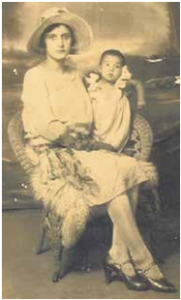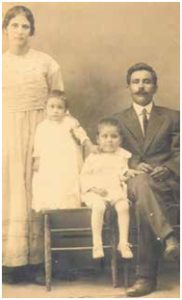The pandemic is more than a health crisis. The pandemic has also caused an economic recession resulting in the loss of millions of jobs across America. In the past four months, cultural institutions, which include museums and libraries, have been especially hard hit.
Some of the smaller libraries and arts programs are closing, and others could well close in the coming months. As one who cherishes knowledge and learning, this worries me. The current younger generation seems addicted to social media, and as a result, spends less time with books. The pandemic has reminded me that we cannot take our access to good books and documents for granted.
Every year my generation grows older and important remembrances can be lost without thoughtful conversations with elderly community members or without a plan to record family narratives. It is imperative to write down important historical moments about our families in the time of the pandemic to safeguard these family and community memories. I have used some of my extra time, while sheltered at home, to explore and write about my family history.
Thus far I have learned that my family’s [Romo and Saenz] earliest arrival to the Americas predates the arrival of the Pilgrims. That is a long story with genealogy evidence, but their narrative has many historical gaps. As a result, I decided to research the lives of Benito and Maria Romo, my paternal grandparents, who emigrated during the Mexican Revolution. I was curious to know how that conflict impacted the decisions of my family to leave a country where they had lived for centuries.
 They were joined in this exodus by more than a million of their countrymen. Their generation represents the first large scale immigration from Mexico. Many of the forty million Mexican Americans currently residing in the United States have a link to the decade of the explosive and destructive Mexican Revolution [1910-1920]. Insights to understand that memory came from conversations years ago with my abuelita, Maria S. Romo.
They were joined in this exodus by more than a million of their countrymen. Their generation represents the first large scale immigration from Mexico. Many of the forty million Mexican Americans currently residing in the United States have a link to the decade of the explosive and destructive Mexican Revolution [1910-1920]. Insights to understand that memory came from conversations years ago with my abuelita, Maria S. Romo.
First, a bit about what I know of her early life. My grandmother was born in Agujita, a small ranching community between the towns of Sabinas and Nueva Rosita, in Coahuila, Mexico. The region was well known for its abundance of natural resources, including coal and iron ore. Not far from the town of Sabinas was the famed Minas de Barroteran. Community residents who did not work in the mines had small farms or tended to small herds of cattle and goats.
After the outbreak of the Mexican Revolution in 1910, the state of Coahuila became one of the epicenters of deadly conflict that took the lives of more than a million Mexicans. A major force at the beginning of the revolutionary fighting in Coahuila was Venustaiano Carranza, the former mayor of Cuarto Cienegas, a town not far from the home of Maria Saenz in Agujita.
Carranza served as a close advisor to Mexican President Francisco I. Madero and as the president’s minister of War. Following the assassination of President Madero in Mexico City in February 1913, Carranza began raising an army in Coahuila to fight the new illegal government. My grandfather, Benito Romo, and Maria Saenz’ brother, Francisco Saenz, both fought in the revolutionary army.
 The Mexican Revolution disrupted the lives of all the families in the region, including the families of Maria and her finance Benito Romo. The conflict shut down the mines and disrupted local businesses for the entire revolutionary period, 1910-1920. Carranza raided the haciendas and mines in search of recruits. But General Carranza was a poor military leader, and early losses to the opposition army led him to aggressive conscription of young men to join his forces.
The Mexican Revolution disrupted the lives of all the families in the region, including the families of Maria and her finance Benito Romo. The conflict shut down the mines and disrupted local businesses for the entire revolutionary period, 1910-1920. Carranza raided the haciendas and mines in search of recruits. But General Carranza was a poor military leader, and early losses to the opposition army led him to aggressive conscription of young men to join his forces.
At this time, Benito and Maria made their decision to seek refuge and work in the United States. Thus, a few months after their marriage, young Maria Saenz, age 14, married and pregnant, bid farewell to her parents. The young couple were joined by her brother Francisco Saenz who had been wounded fighting with the rebel bands organized in Coahuila.
My family emigrated to the United States as a result of turbulent times in Mexico. They were welcomed by Texas farmers and industrialists who needed crops picked and railroads built. Companies that built homes as well as meatpackers and cattle ranchers also sent recruiters to the border. The labor recruiters stood at the international border with grand promises of good wages and comfortable surroundings, promises that were seldom kept.
The Romos left Coahuila via old roads built in colonial times to Piedras Negras, the border town across from Eagle Pass. Maria Romo recalled years later that their travel north to the U.S. border seemed farther than the actual 60 miles. No doubt it was because they made their trip to the border by horseback and on foot. They crossed the international border at Piedras Negras.
Prior to the creation of the U.S. Border Patrol, Mexican immigrants who crossed into American border towns, such as Eagle Pass, needed only to provide their names and birthplace. Likely recruited by labor agents representing cotton farmers, the Romos boarded a train in Eagle Pass and headed for Kyle, Texas.
My grandmother recalled that the cotton growers provided living quarters that had previously sheltered farm animals. By day they worked in the cotton fields where the hot sun and dust left them exhausted. If they fell ill, they had access to little or no medical attention.
My grandmother gave birth to her first child, young Benito junior, in a make-shift shelter surrounded by barns and cotton fields. She told me that in her second pregnancy, her newborn died within weeks due to cold and rainy weather that made it impossible to warm their quarters.
When she was pregnant with her third baby the following winter, she decided that her future babies must be delivered in San Antonio, preferably in a hotel. In the winter of 1917, Maria Romo gave birth to my aunt, Consuelo Romo in a small hotel near the San Antonio railroad station. The following year she gave birth to my dad, Henry Romo. Later they found a small rental house near the old Mercado on Houston St. The Romo family decided to stay in San Antonio and began their journey toward the American dream of steady work and home ownership.








